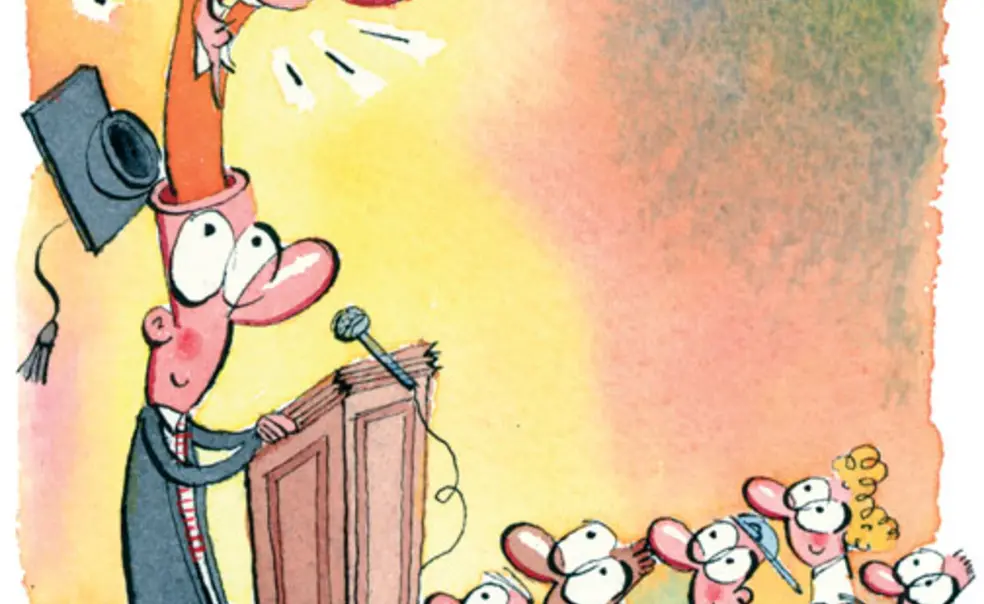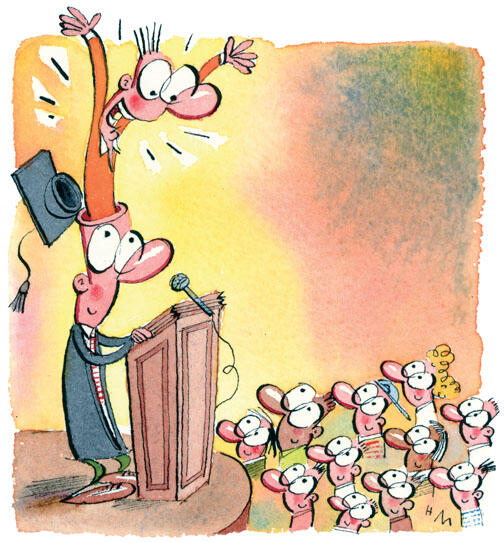Graduate-student humor; Native American pride
It wasn’t your typical graduate seminar in Lewis Thomas Lab, but then, it wasn’t your typical seminar speaker, either.
Adam Ruben ’01, a molecular biology major who developed a standup comedy act while earning his Ph.D. at Johns Hopkins, was back on campus May 6 to promote his new book, Surviving Your Stupid, Stupid Decision to Go to Grad School.
Describing the process of doctoral research, Ruben said: “You take a tiny corner of the universe that a professor finds fascinating and bury your face in it, only looking up occasionally to steal unattended bagels.”
The pressure and stress of graduate work often come to a head as Ph.D. candidates study for general exams, which Ruben termed a rite of passage. That struck a chord with Michael Mooney, a physics graduate student who recalled his experience preparing for generals: “I used to fall asleep on my desk every half-hour studying for generals,” he said. “My professor would see me and say, ‘This is my graduate student!’ ”
During his talk to about 20 graduate students, Ruben read a short chapter of his book titled “Edit? Forget It,” commenting that faculty sometimes can show a low regard for the intellectual capabilities of their graduate students. Tom Scherer, a graduate student in politics, agreed: “Year one, you learn you’re an idiot. Year two, you are confused why they would give you so much work when they know you’re an idiot. “
Ruben said he was surprised to learn that while institutions may vary, “There’s definitely a general grad-student attitude and a way of thinking about yourself and about academia.”
That attitude requires the ability to poke fun at yourself and your surroundings, said Eric Melancon, a master’s-degree student in the Woodrow Wilson School. “You can either laugh about it, or you can work in a small dark room eating processed foods,” Melancon said. “I choose the former — you have to have a sense of humor!”
And despite the quirks of a grad student’s life, Scherer added, “I am glad that I’m here and not working a real job.”
By Isabel Pike ’11
The drums could be heard across campus as the Silvercloud Singers, an intertribal Native American singing and dance troupe, performed at the annual “mini powwow” held by the student group Native Americans at Princeton (NAAP) April 16 in front of Dillon Gym.
The event — held on a weekend when hundreds of high school students who had been admitted to Princeton were on campus — was the largest of the year for the group, said Veronica Watters ’12, a Lakota tribe member who grew up on the Pine Ridge Reservation in South Dakota.
“Hopefully, in the future, we’ll have students dancing” who are familiar with the native dances, Watters said.
Given the size of Princeton’s native population, Watters’ plan is ambitious. This year, 25 undergraduates identified themselves as American Indian or Native Alaskan — about 0.5 percent of the student body.
“The group is small but strong, and we want to make it bigger and stronger,” said Miguel Sansalone ’10, a former president of NAAP whose mother is Comanche.
“I knew there wasn’t a big Native community at Princeton, but I was fine with that,” said Watters. Growing up, she said, her father had taught her Lakota prayers and smudging, a cleansing ritual that involves burning sweet grass and sage. A premed student, Watters said she plans to return to Pine Ridge. “Knowing how much my ancestors did to keep culture alive, I want to do the same,” she said.
Sansalone, an anthropology major from Oklahoma City, said he feels that he is “constantly talking about being Indian, partly because there are so few of us.” He said he would like to see Princeton offer more courses on Indian culture and hire Native American faculty members.
Admission dean Janet Rapelye said Princeton is “committed to finding Native American students, and the pool of candidates is small. We win these students one by one.”
At the powwow, students enjoyed sampling fry bread, a deep-fried doughy treat, while watching dances and songs from tribes across the country. “This is a great way to show that there is such a group on campus and that they are active,” said Shannon
Rice ’12.













No responses yet